How to Upgrade the RAM in your Synology DS1522+ to 32GB and 64GB RAM Officially/Unofficially
The Synology DS1522+ NAS is a NAS system that arrives with an impressive middle ground between Power, Efficiency and Price, thanks to that AMD Ryzen R1600 CPU, flexibility in a 10GbE upgrade, storage expandability and (of course) arriving with ECC memory. The DS1522+ is one of the latest generation of Diskstation devices (in the 2022/2023 series) that seems to be targeting the more advanced SMB user, prioritizing throughput and performance, whilst also doubling down on data integrity with things like BTRFS and ECC memory. However, the system arrives with 8GB, but can be upgraded officially to a very impressive 32GB (for the scale of the system)! So, there are users that might want to upgrade that memory on Day 1 in order to remove any kind of potential bottleneck down the line (VMs, Databases, Surveillance, etc) or even just users that have set up the device to their own unique setup – but noticed that Memory usage is constantly hovering at the 60-70%. Synology NAS systems use quite proficient intelligent background memory use and flushing, but nevertheless, there are still plenty of users who want to scale up the base-level memory. In this article, I will show you how to upgrade the memory on your Synology DS1522+ NAS, but also I will show several 3rd party (i.e Unofficial modules) that I have tested in this NAS.
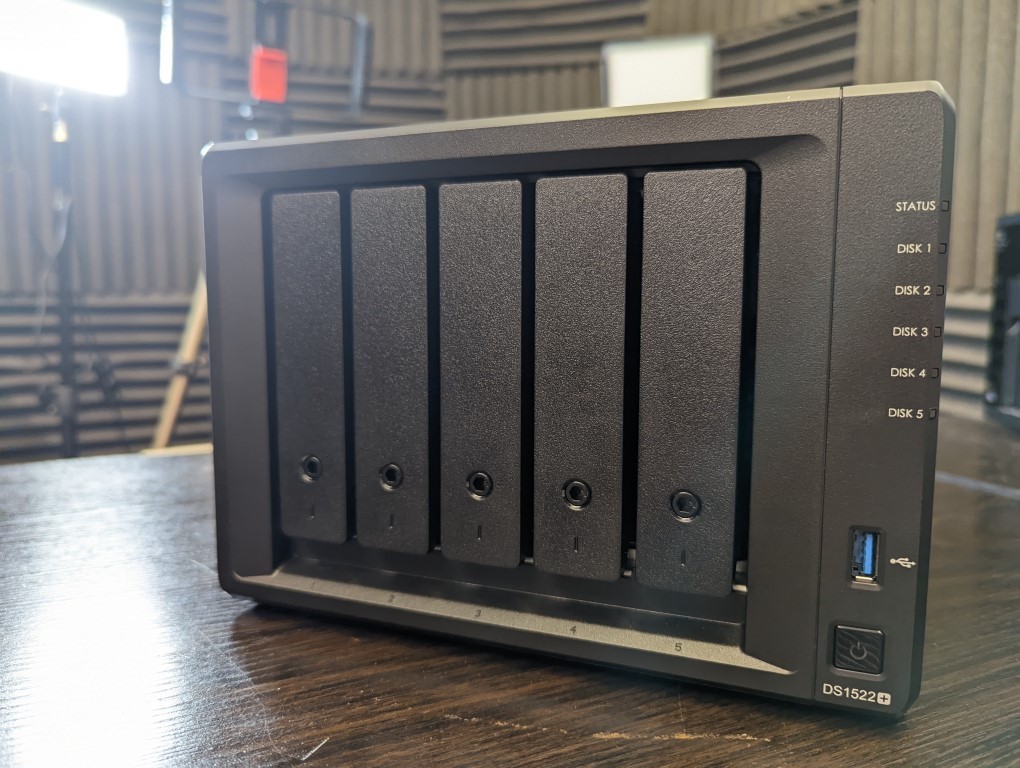
Upgrading your Synology DS1522+ with Unofficial Memory – Pay Attention
Before we continue with the guide, it is worth highlighting that the DS1522+ manufacturer, Synology, strongly recommends that you do not exceed the stated memory limit on their specifications page. They also highlight that using non-official memory in your Synology DS1522+ may well result in them being unable to provide technical support, as this would be an unsupported setup. We at NASCompares cannot be held accountable for how you use this guide. However, below I will show you where to buy the individual memory and Synology DS1522+ NAS device you will need. ONLY attempt this upgrade if you are comfortable with the terms laid out above by the manufacturer. Finally, it is also worth remembering that just because a system can SEE more than the official maximum memory, there is no guarantee that you will be able to utilize the full visible memory at once. Synology’s recommendations on the maximum memory supported by their NAS systems are often governed by three factors:
- The Recommended Maximum Supported Memory detailed by the CPU Manufacturer (e.g. Intel or AMD), which can also be a case of lanes and bandwidth allocation/availability
- The number of memory slots that Synology add to the system. This can be a case of a NAS only having 2 slots (with only 32GB modules supported by the brand) but the CPU supporting more than that being a physical conflict
- The Synology NAS might arrive with fixed/soldered memory for it’s default memory (e.g. the 2GB in the DS423+ or 4GB in the DS920+) but might also have a free memory upgrade slot – this leads to unusual memory caps such as the 6GB Maximum on the DS423+, despite it’s CPU supporting upto 8GB.
If you choose to go ahead with unofficial memory, afterwards, it is highly recommended to test the full quantity available with VM testing (assigning bulk memory to each virtual image) and running at the same time to see if it is utilized.
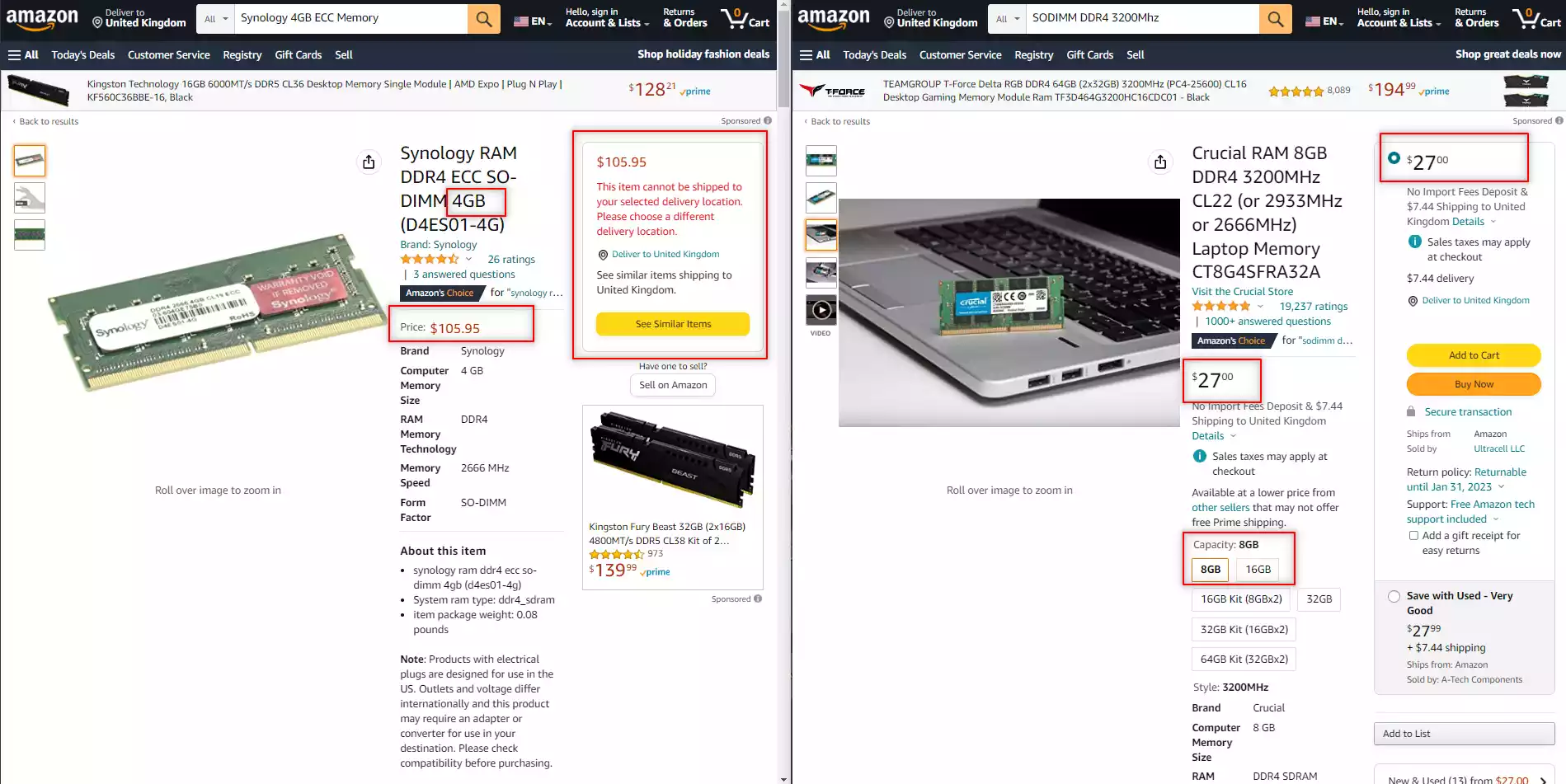
Synology Official Memory vs Unofficial Memory from Crucial, Kingston, Sabrent, etc?
Luckily Synology provides a wide range of official memory upgrades that can be purchased from numerous retailers online, however, they are generally more expensive than the 3rd party equivalents (see example above). Now, there could be a few good reasons for this. Firstly, these memory sticks are first-party and specifically selected to work on the Synology NAS systems (taking alot of the searching out of it for people in researching speeds, frequencies and supported PIN numbers), and officially branded components for any hardware manufacturer are always pricier.
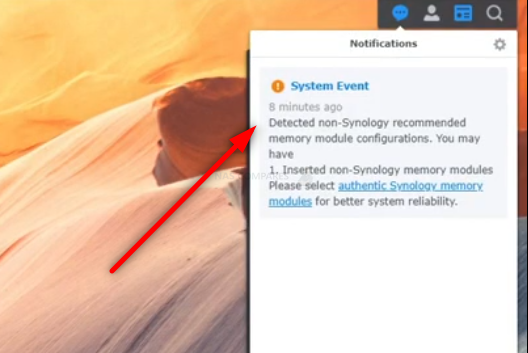
Next, they do not have the rotation of stock that Crucial or Kingston has and therefore, the flexibility in pricing they might have is not available. Lastly, the Synology memory will often be ECC memory (especially in recent released NAS systems by them) and ECC memory always commands a higher price. However, given this memory is likely manufactured by a 3rd party, that does make it a little painful sometimes for smaller Synology NAS users who look at official memory and its often 2-3x pricepoint of equivalent modules from Kingston, Crucial and Samsung. So, in this guide we talk about upgrading your memory with both official and unofficial memory, what happens when you do and if there are risks to factor in. If you are a little unsure about whether you need to use ECC memory in your specific Synology NAS setup, you can watch the video below detailing the pros, cons and more:
Synology DS1522+ Official/Unofficial Memory Upgrade – Step 2, Physical Installation
What you will need:
- A Synology DS1522+ NAS – Obviously
- 1/2x Memory Upgrade Modules (Ranging from 4GB to 16GB and 32GB Individual Modules – Link below for Tested RAM modules from Crucial, Kingston, Samsung, Timtec and Synology Official Memory too:
| DS1522+
(Arrives with ECC Memory) |
DDR4-2466 ECC Unbuffered SO-DIMM 260pin 1.2V | D4ES02-8G (ECC)
D4ES01-16G (ECC) |
Crucial ECC 4GB – Buy Here
Kingston NON-ECC 4GB- Buy Here Crucial NON-ECC 8GB – Buy Here Kingston NON-ECC 8GB- Buy Here Crucial NON-ECC 16GB – Buy Here Kingston NON-ECC 16GB- Buy Here Kingston NON-ECC 32GB – Buy Here Kingston ECC 8GB – Buy Here Arch ECC 16GB – Buy Here vColour ECC 32GB- Buy Here |
VERY IMPORTANT – The Links used in the article below towards the correct unofficial memory are occasionally changed (beyond my control) as it will direct you to the site in your own region/country. MAKE SURE to check that the memory module (especially 16 and 32GB SODIMM modules) are DUAL RANK or ‘DR‘, as Synology NAS typically have trouble with SR/SINGLE RANK modules.
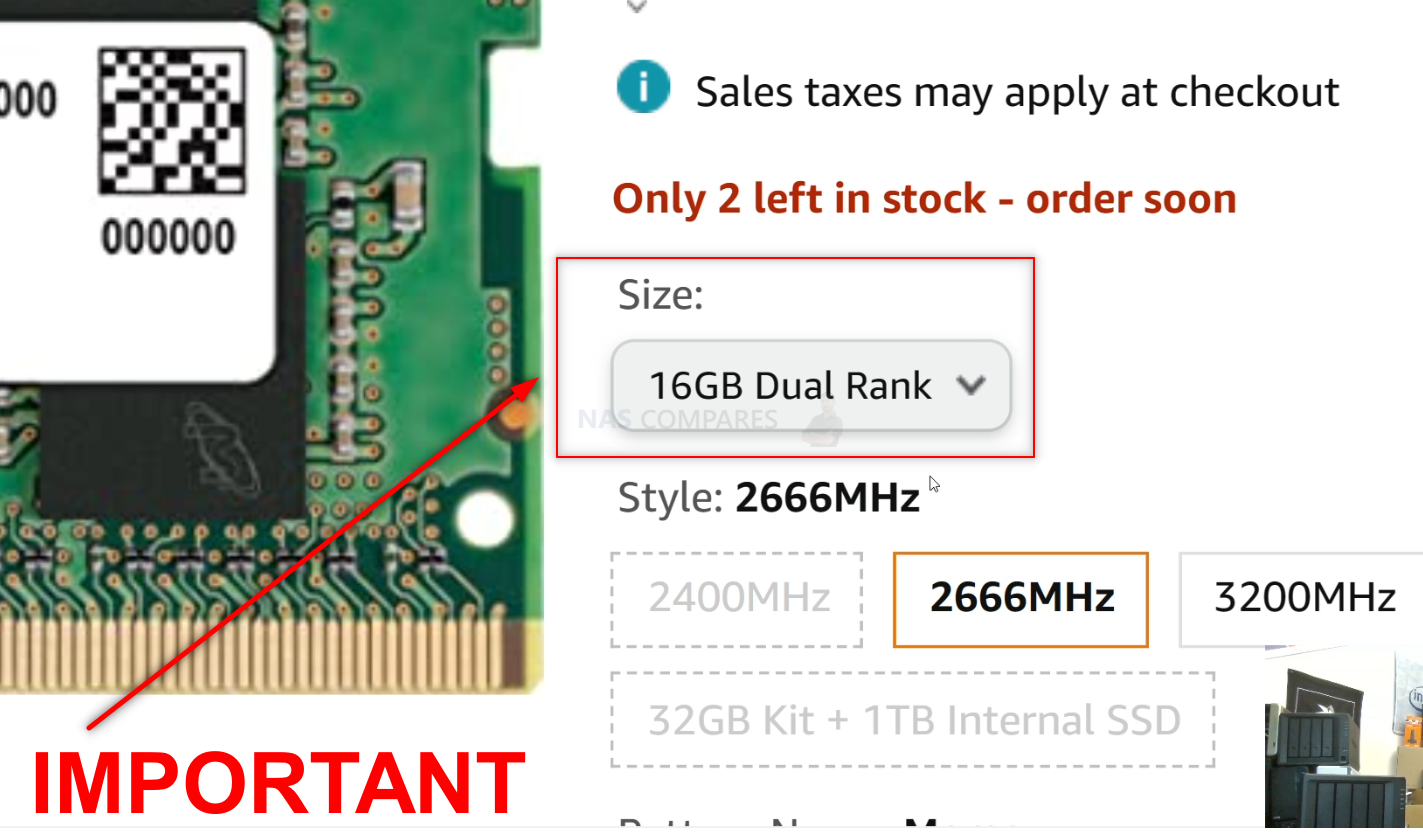
- (OPTIONAL) Anti-static gloves and Envelope – useful to eliminate static charges and also to store the removed older official memory sticks):
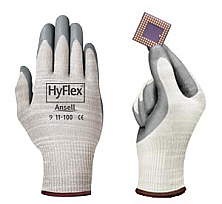 |
 |
First, we need to ensure the Synology DS1522+ is completely powered down/off and the mains power has been disconnected. It is recommended that you remove the Hard Drive or SSD that you have installed before accessing the RAM as it may block the slots. Additionally, you should remove the hard drive media as the unit will be moved around a lot during the memory installation and this could damage the drives. Be sure to keep a note of the drives that you remove and the order they were installed (HDD Bay 1, HDD Bay 2, etc) as installing the drives in the wrong slots could damage any existing RAID you have setup internally.
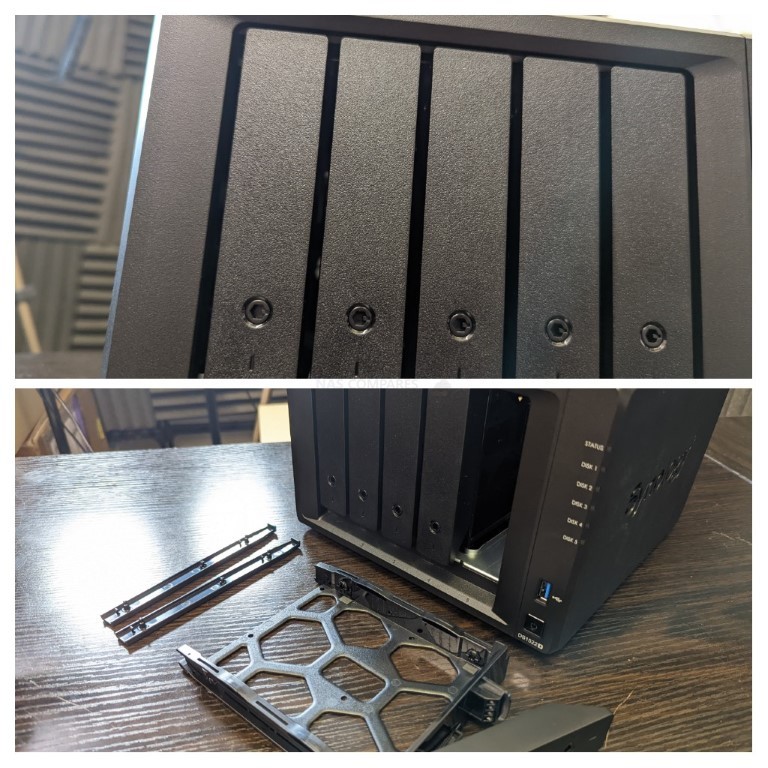
Next, we need to access the memory upgrade panel. Now, if you are just adding the existing memory, you can just add the additional module to the available SODIMM slot. However, if you are upgrading the system’s memory with new pairs of memory sticks (eg upgrading from the default 8GB to 32GB with 2x16GB), you will need to remove the old memory (remember to store it in an antistatic bag afterwards)
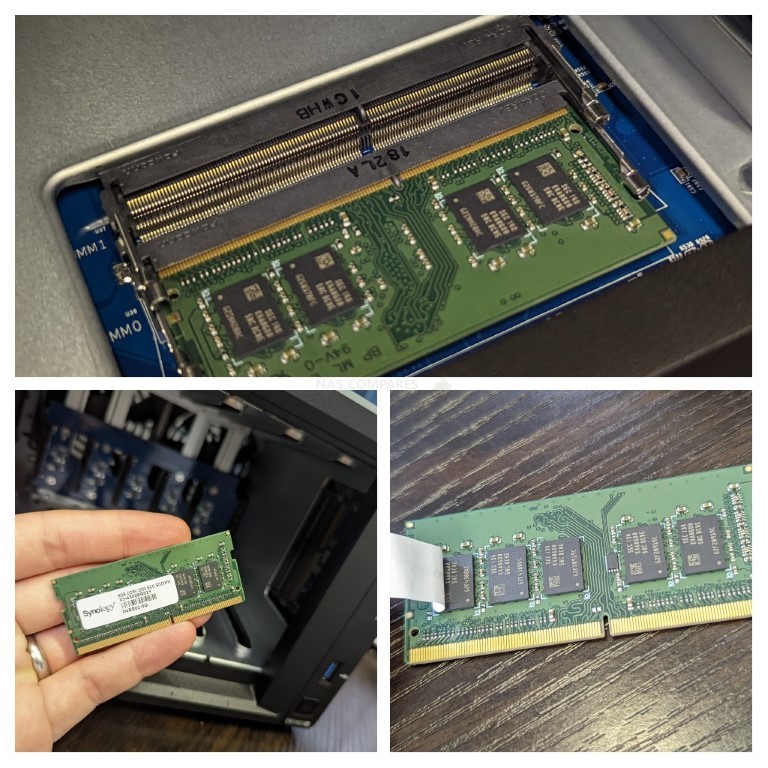
If you are removing the original memory, be sure you eject the official memory sticks using the clips on either side of the slot, as well as only holding the memory sticks by the narrow side edges, never touching the chips or board of the money or NAS.
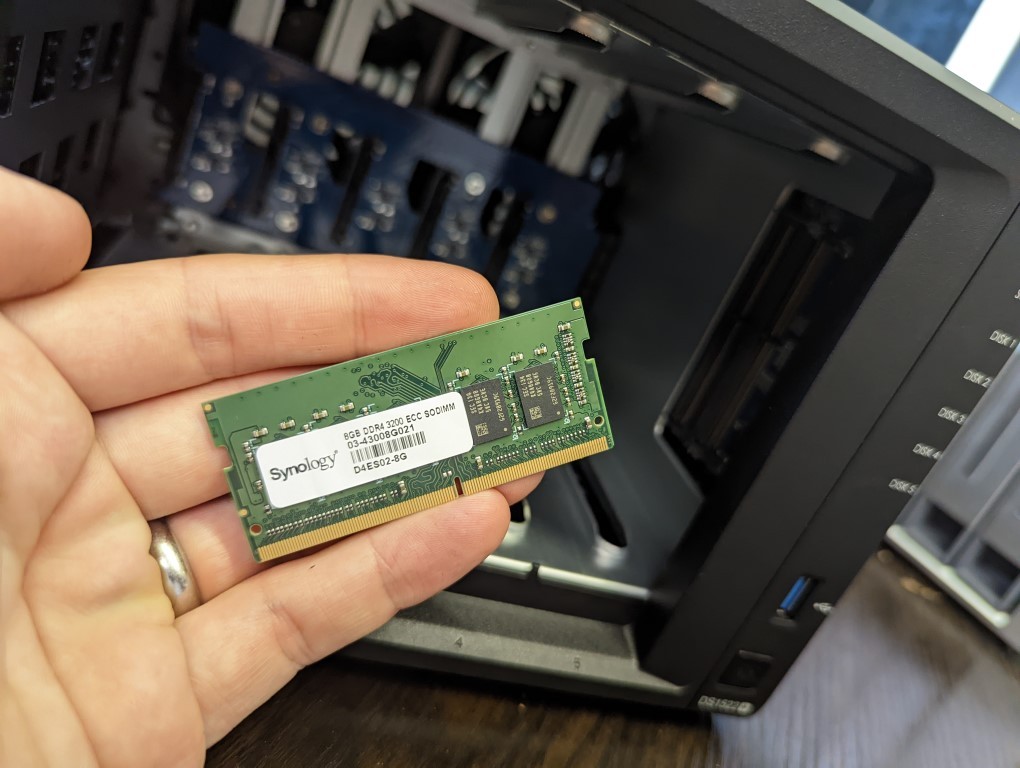
Once you have removed them, they can either be stored away for a later project, installed in a compatible laptop or sold on eBay etc to make a little cash back!
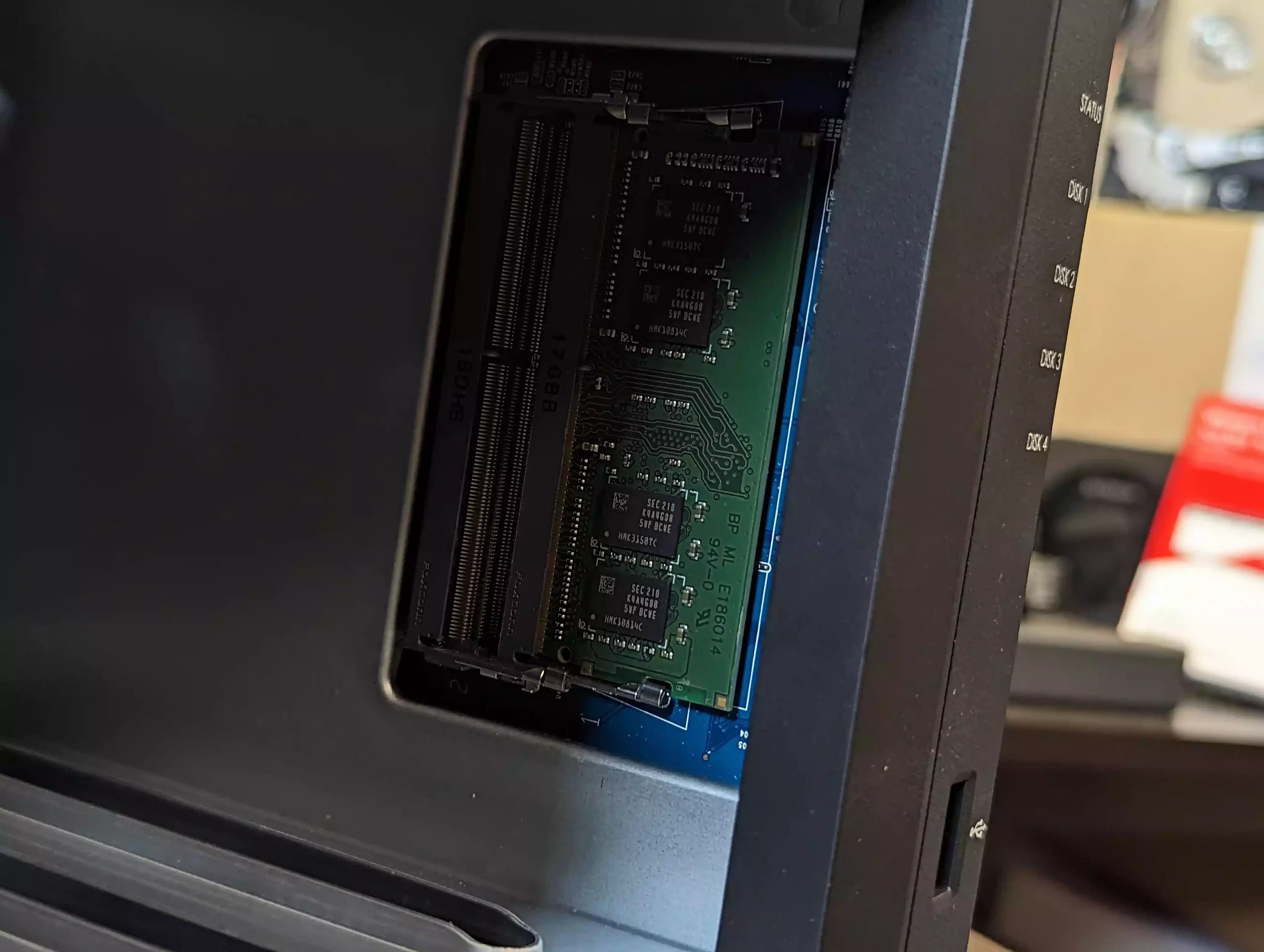
Once they are clear, install one or both of your chosen unofficial DDR4 SODIMM memory modules in the available slots, making sure that you click them both in with the clips on either side.
Synology DS1522+ Official/Unofficial Memory Upgrade – Step 2, Checking the Unofficial Memory is Recognized
What you will need:
- A web browser (Chrome, Safari, Firefox, etc) on a Windows, Mac or Android Machine) accessing the Synology DS1522+ user-interface as you normally would.
Next, you need to power up your Synology DS1522+ NAS and access it as you normally would. If you are buying this NAS first time and have yet to set it up, there are numerous first-time set-up guides and tips on the YouTube channel here – that will get you from the hardware installation to set up the Synology DS1522+ NAS for use. Once the NAS user interface (UI) is ready to go, head over to the hardware specification page shown here:
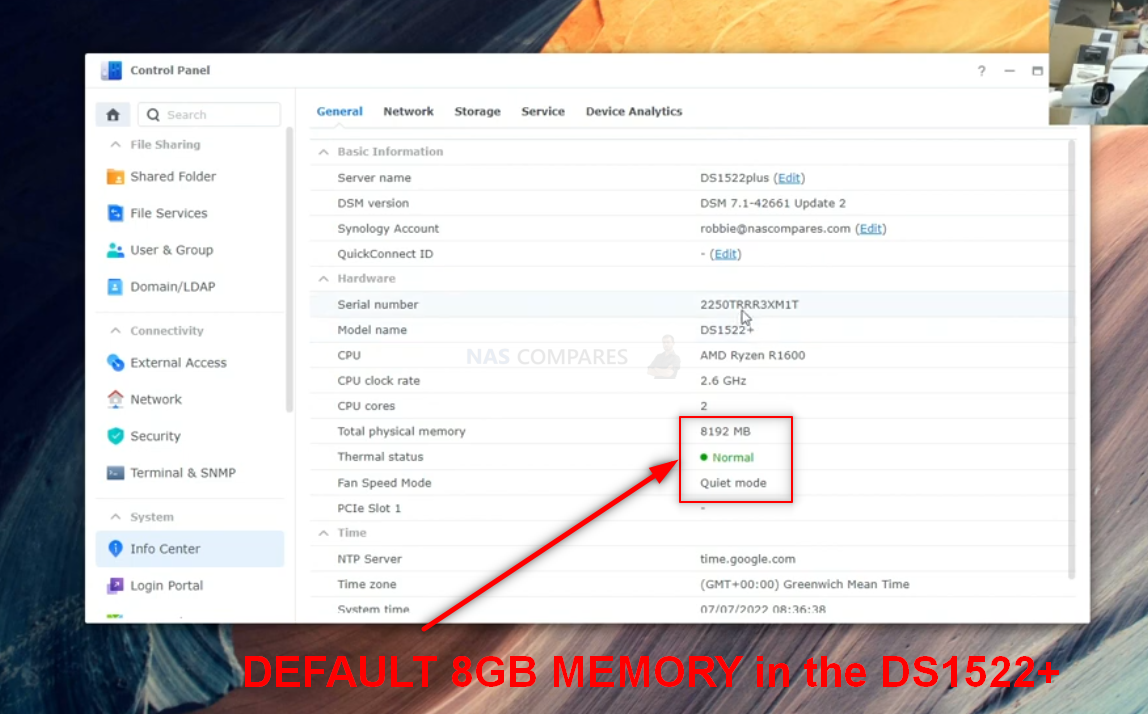
As you can see in the image above, the Synology has recognized the increased memory. It is still recommended to head to Step 4 below to see how to use the official memory test feature of the system.
Synology DS1522+ Official/Unofficial Memory Upgrade – Step 3, Unofficial/Unsupported Memory Tested
As mentioned earlier, Synology is pretty clear about its position on users opting for non-Synology memory in their systems or exceeding the officially stated maximum capacity of the DS1522+. They feel this is using the system in a configuration that is outside of the guaranteed performance and stability that they advertise. This means that if your system encounters issues as a result of these unsupported configurations, they (at best) will have difficulty recreating this configuration to provide support or (at worst) refuse to provide support as they have been pretty clear on the setups that they state the DS1522+ can run with. However, there is no avoiding that there have been countless examples of Synology NAS systems functioning perfectly well with 3rd party memory (YouTube Playlist of Synology NAS 3rd Party memory Tests HERE), so here are some examples of memory modules we tested on the Synology DS1522+ NAS (including model ID and links as needed – again, DOUBLE CHECK THE MODEL ID before you buy, as retailers will check page links):
Synology DS1522+ NAS + with 2x Sabrent Rocket 16GB 3200Mhz DDR4 SODIMM (2x 8GB also tested)
Sabrent Memory 2x DDR4 SODIMM SB-DDR8 8GB HERE – (8/16/32GB Available):
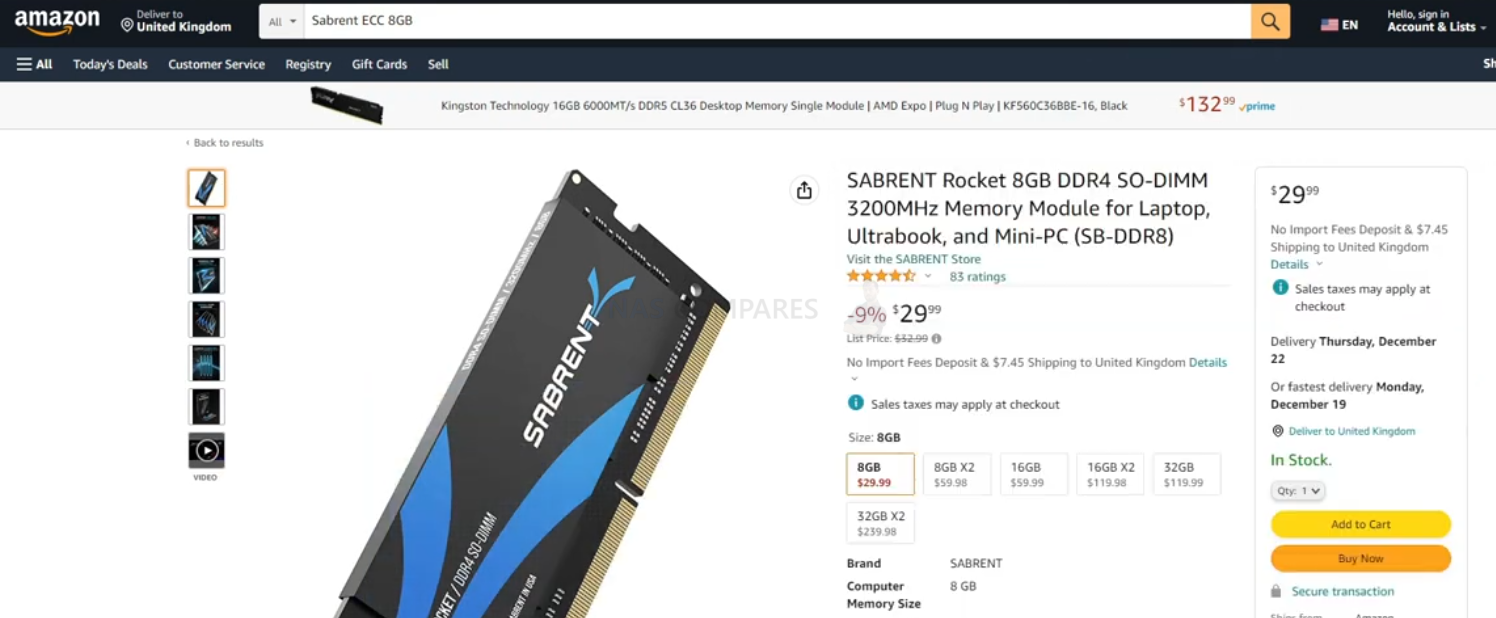
After installation, I checked the Synology Resource Monitor and the Sabrent memory was recognized:
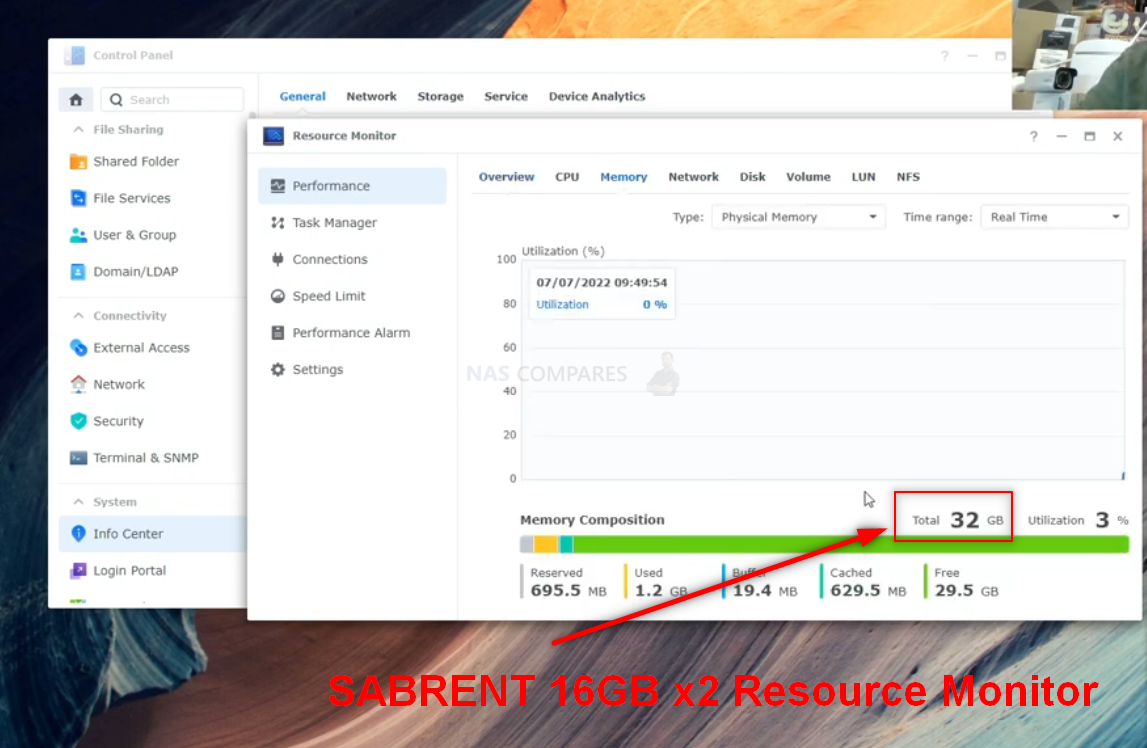
Heading into the system information, once again, the 2x 16GB Memory was recognized as recognised in total available physical memory:
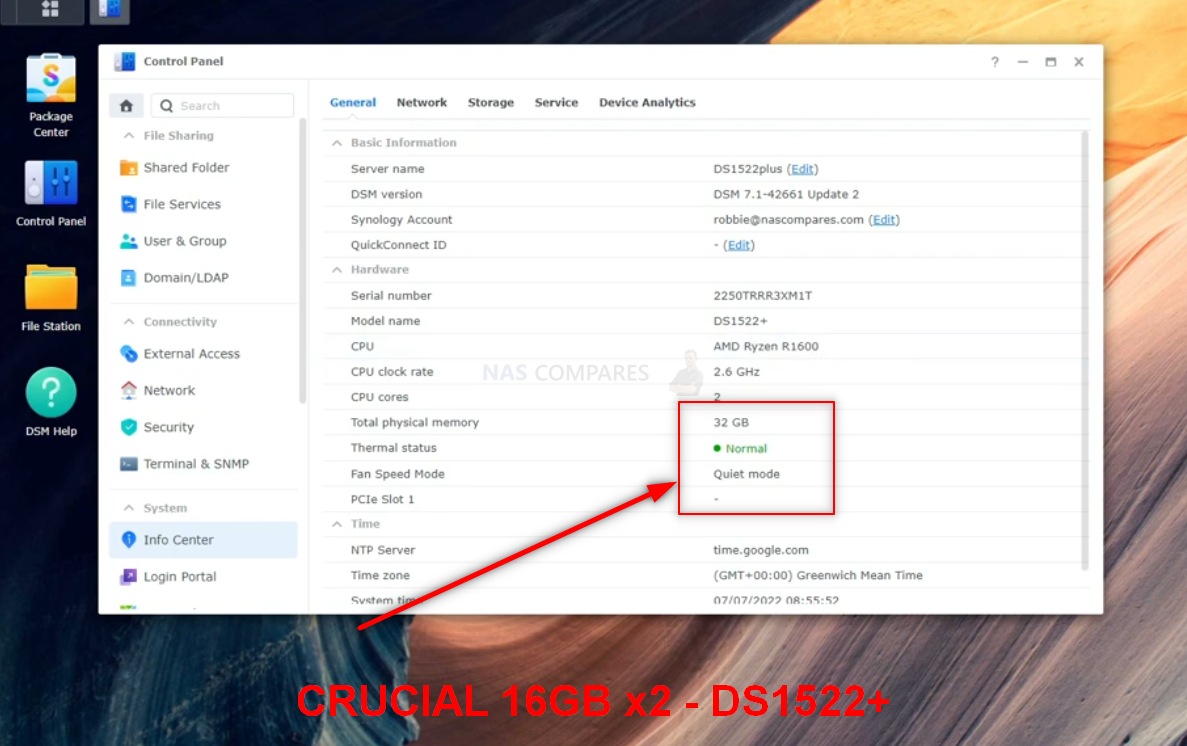
Heading into the Virtual Machine Manager and assigned a massive chunk of the available memory to an Ubuntu VM to see if the system would have any issue with assigning it. No barriers or hurdles were raised.
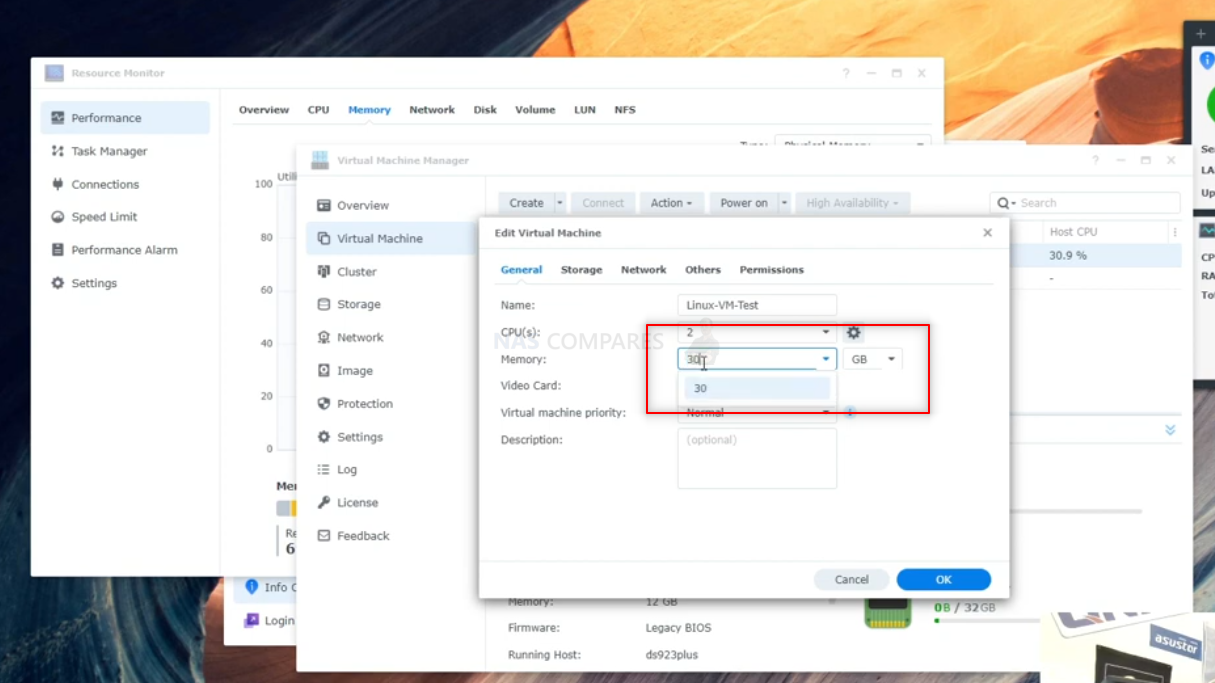
Booting the VM, We were able to head into the Ubuntu System Monitor and see that the memory quantity was successfully allocated to the Virtual Machine:
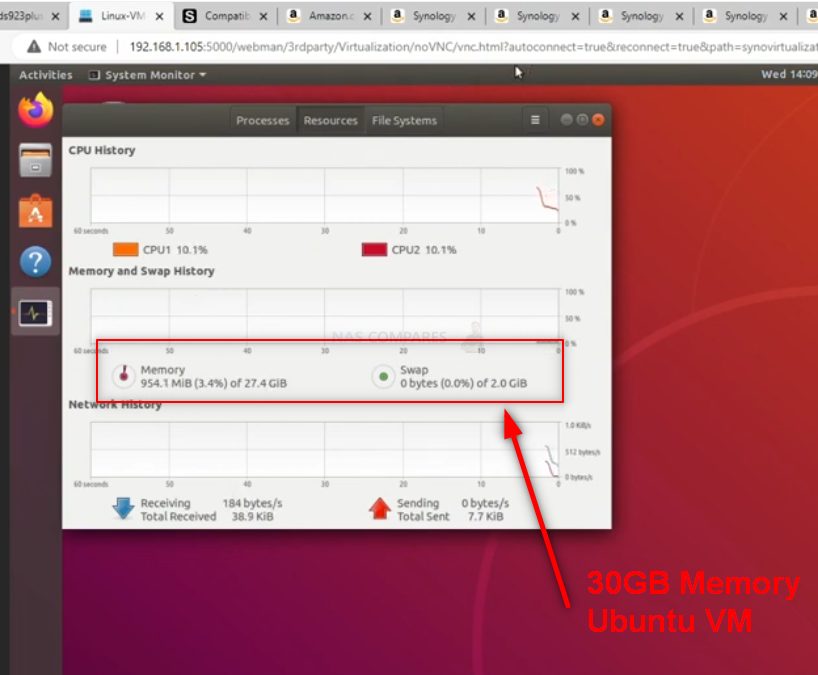
Synology DS1522+ NAS + with 2x Crucial 16GB 3200Mhz DDR4 SODIMM
Crucial Memory 2x DDR4 SODIMM CT16G4SFRA32A – (8/16/32GB Available):
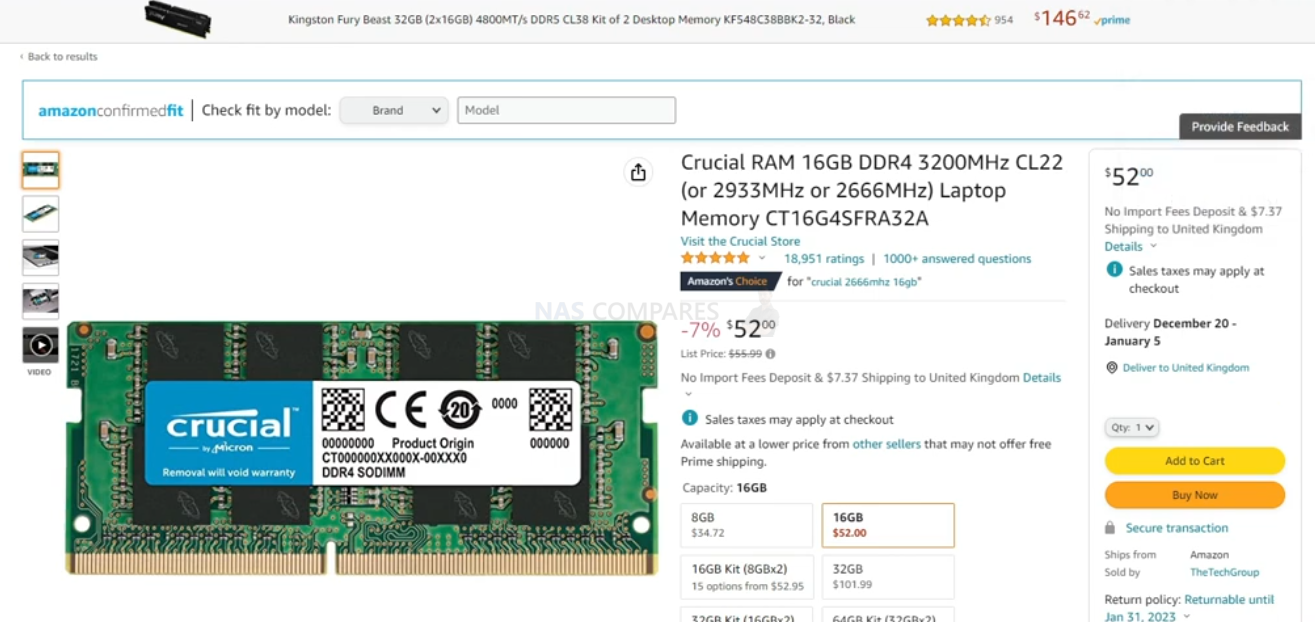
After installation, I checked the Synology Resource Monitor and the Crucial memory was recognized:
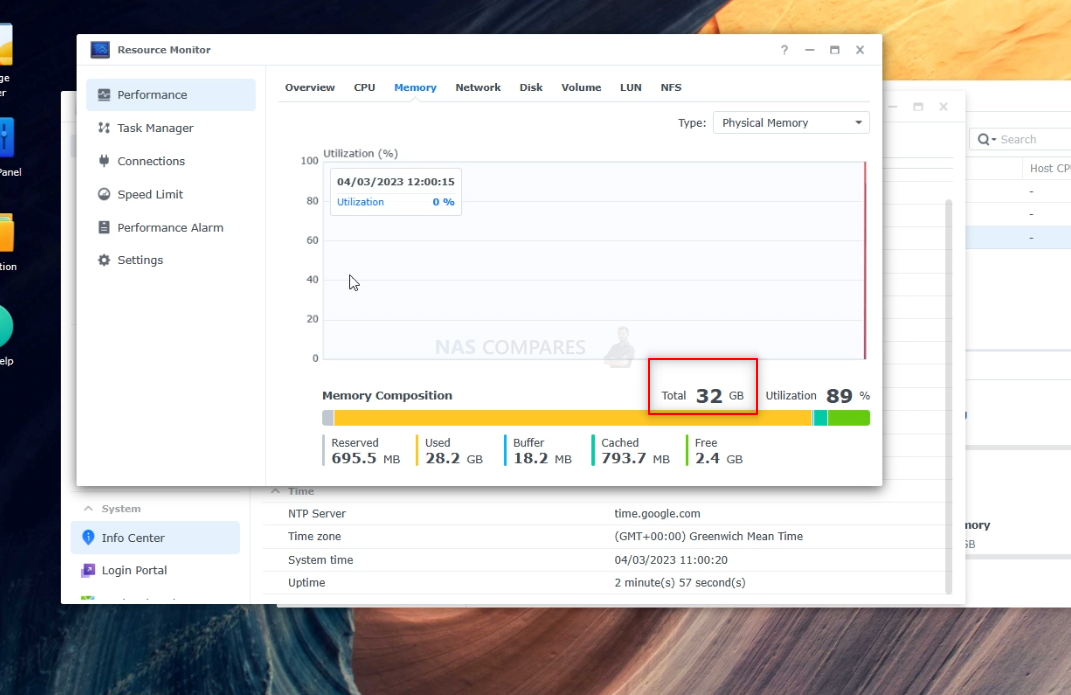
Heading into the system information, once again, the 32GB Memory was recognized as recognised in total available physical memory:
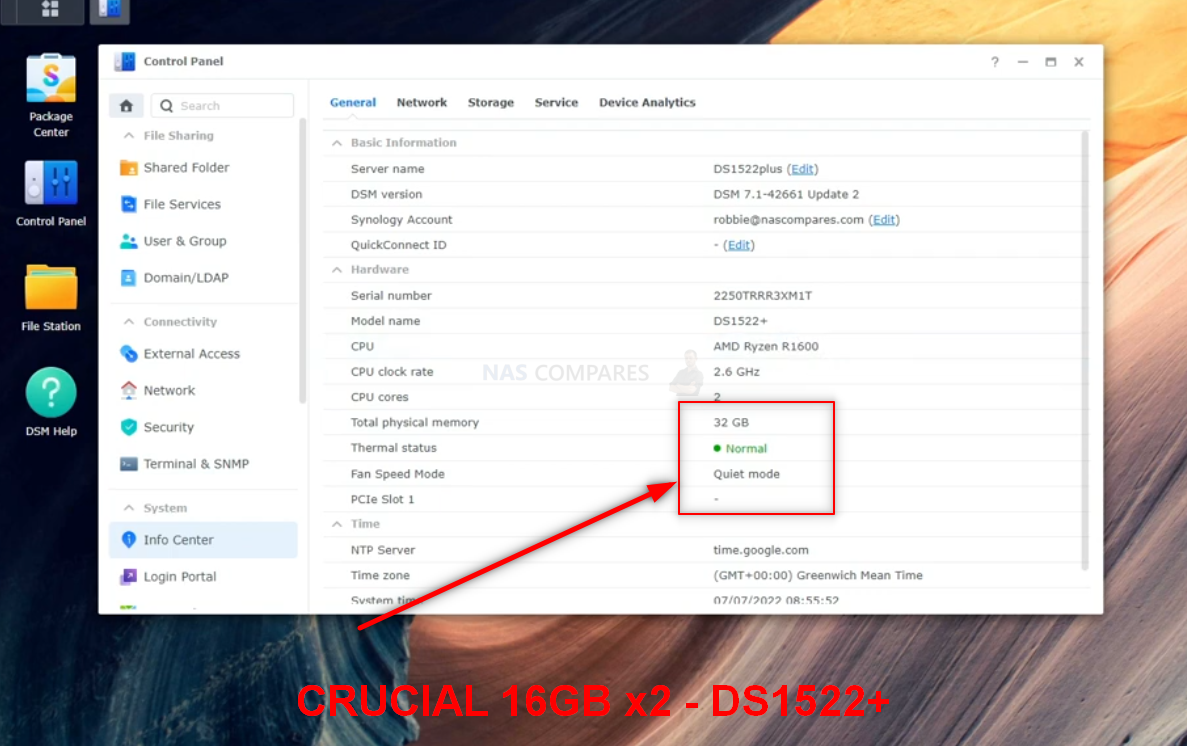
Heading into the Virtual Machine Manager and assigned a massive chunk of the available memory to an Ubuntu VM to see if the system would have any issue with assigning it. No barriers or hurdles were raised.
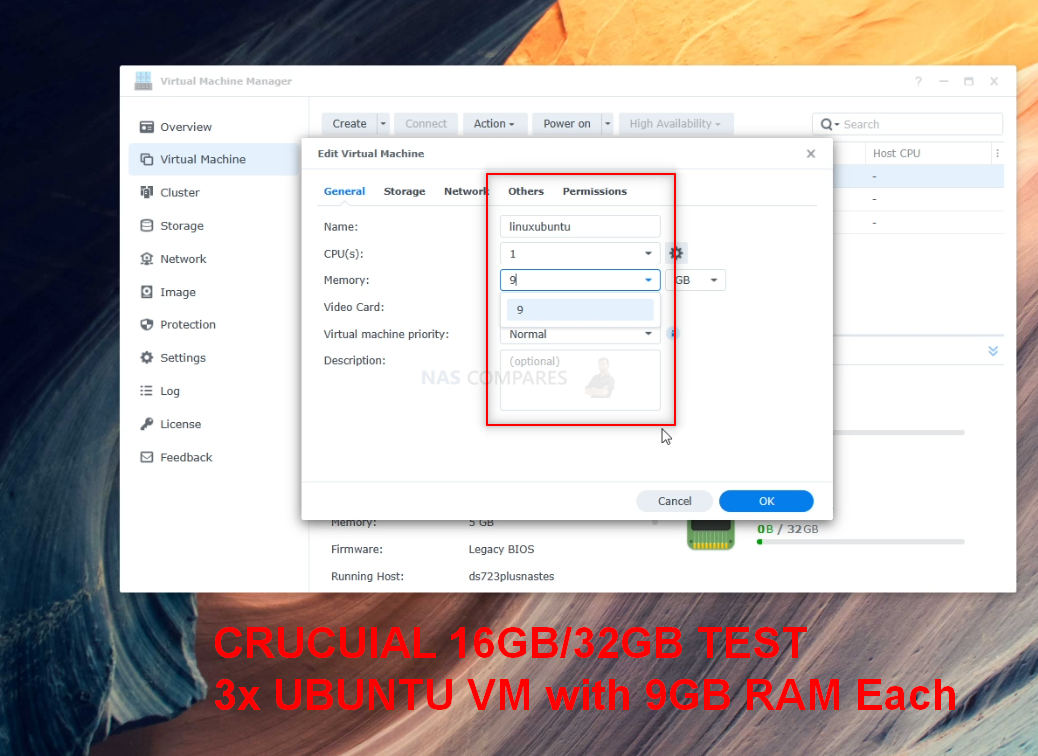
Booting the VM, We were able to head into the Ubuntu System Monitor and see that the memory quantity was successfully allocated to the Virtual Machine:
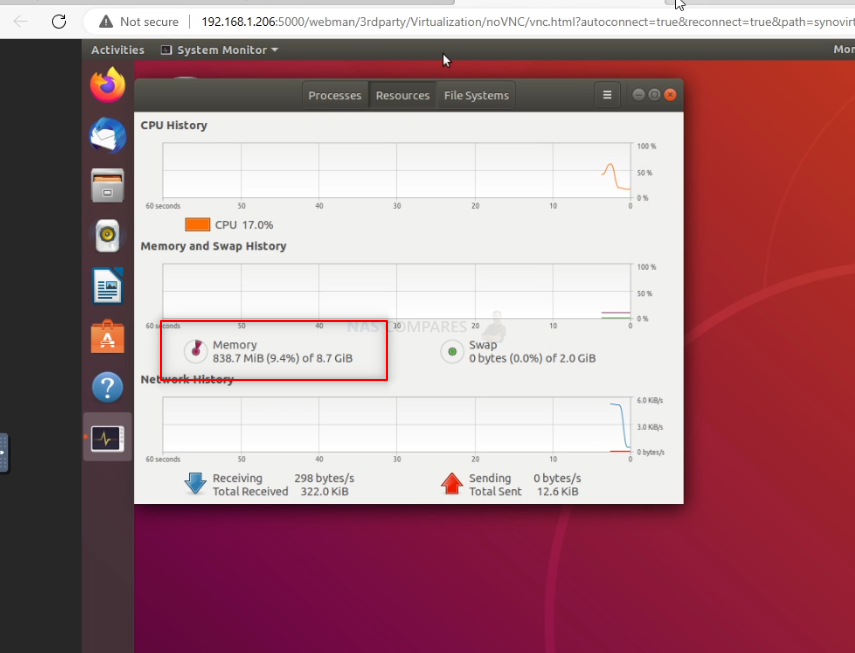
Synology DS1522+ NAS + with 2x Kingston 32GB 3200Mhz DDR4 SODIMM
Kingston Memory 2x DDR4 SODIMM KCP432SD8/32 – (8/16GB Available):
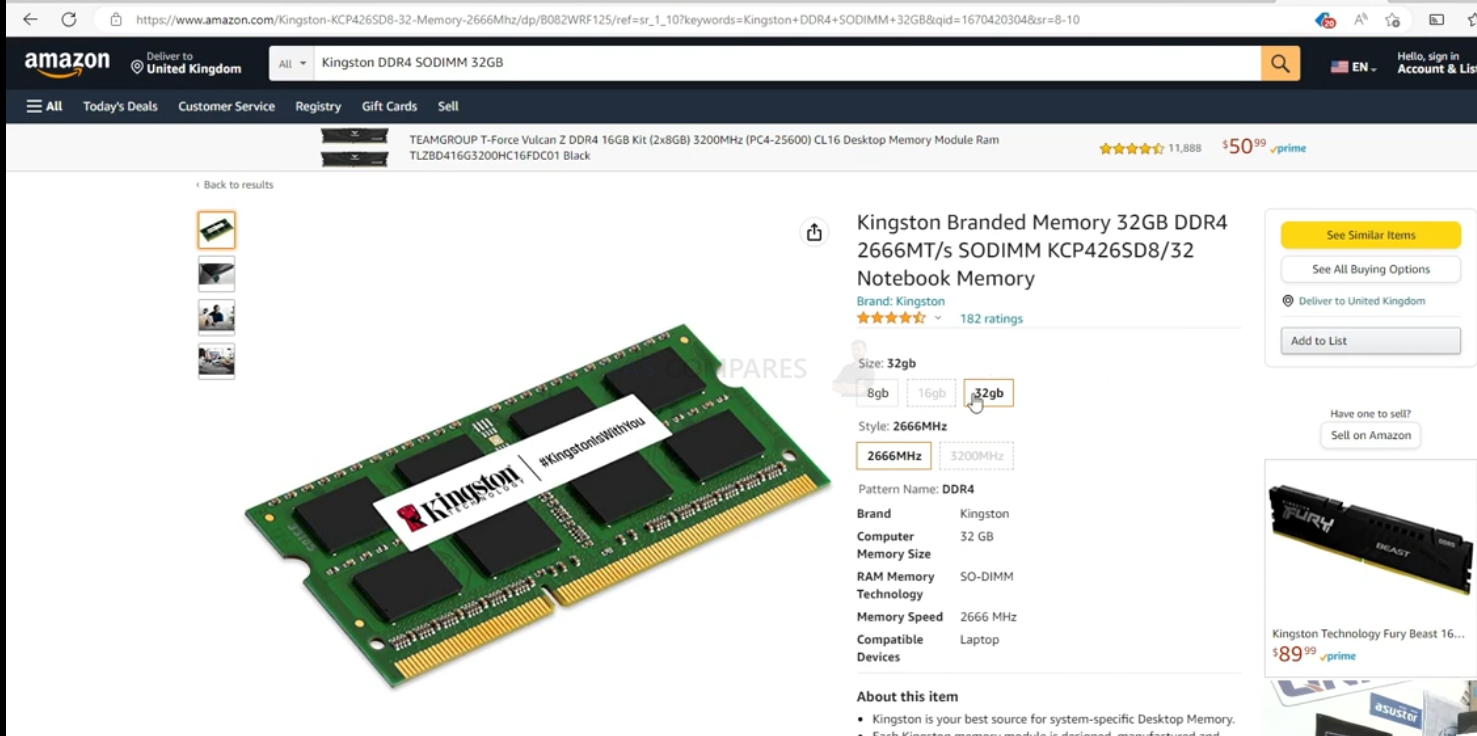
After installation, I checked the Synology Resource Monitor and the Kingston memory was recognized:
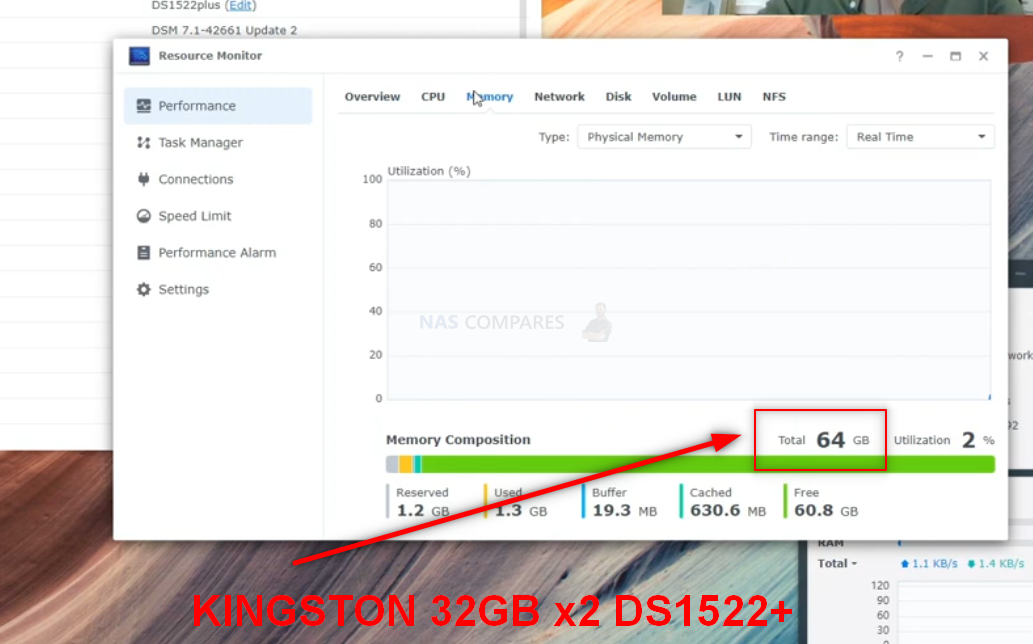
Heading into the system information, once again, the 64GB Memory was recognized as recognised in total available physical memory:
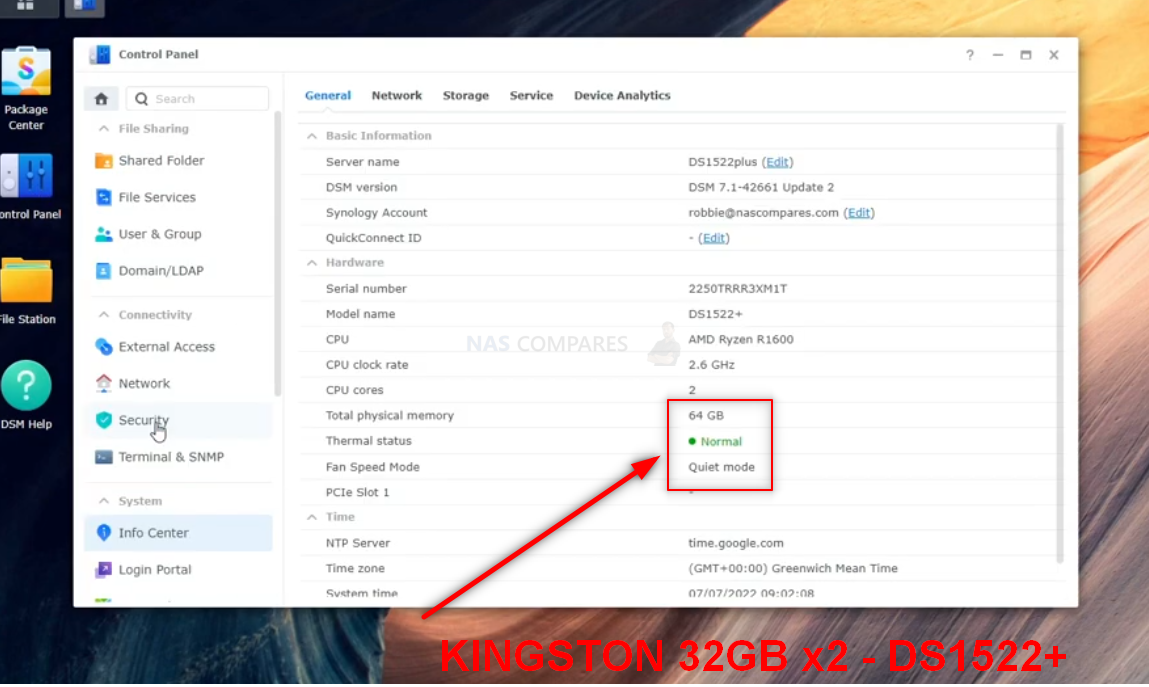
Heading into the Virtual Machine Manager and assigned a massive chunk of the available memory to an Ubuntu VM to see if the system would have any issue with assigning it. No barriers or hurdles were raised.
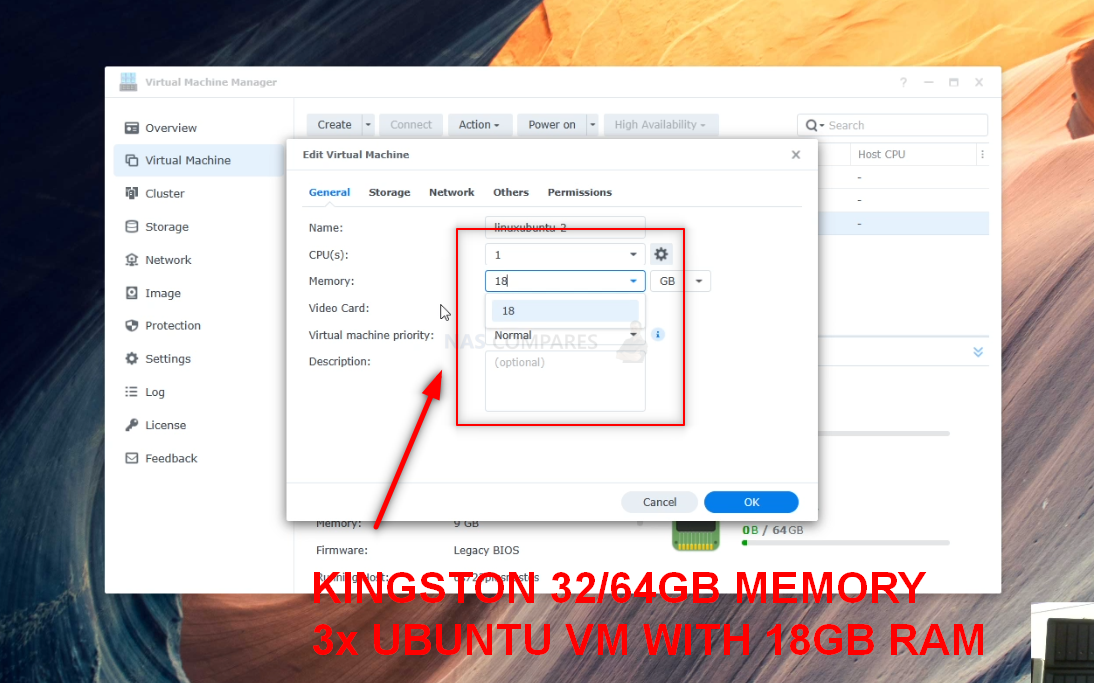
Booting the VM, We were able to head into the Ubuntu System Monitor and see that the memory quantity was successfully allocated to the Virtual Machine:
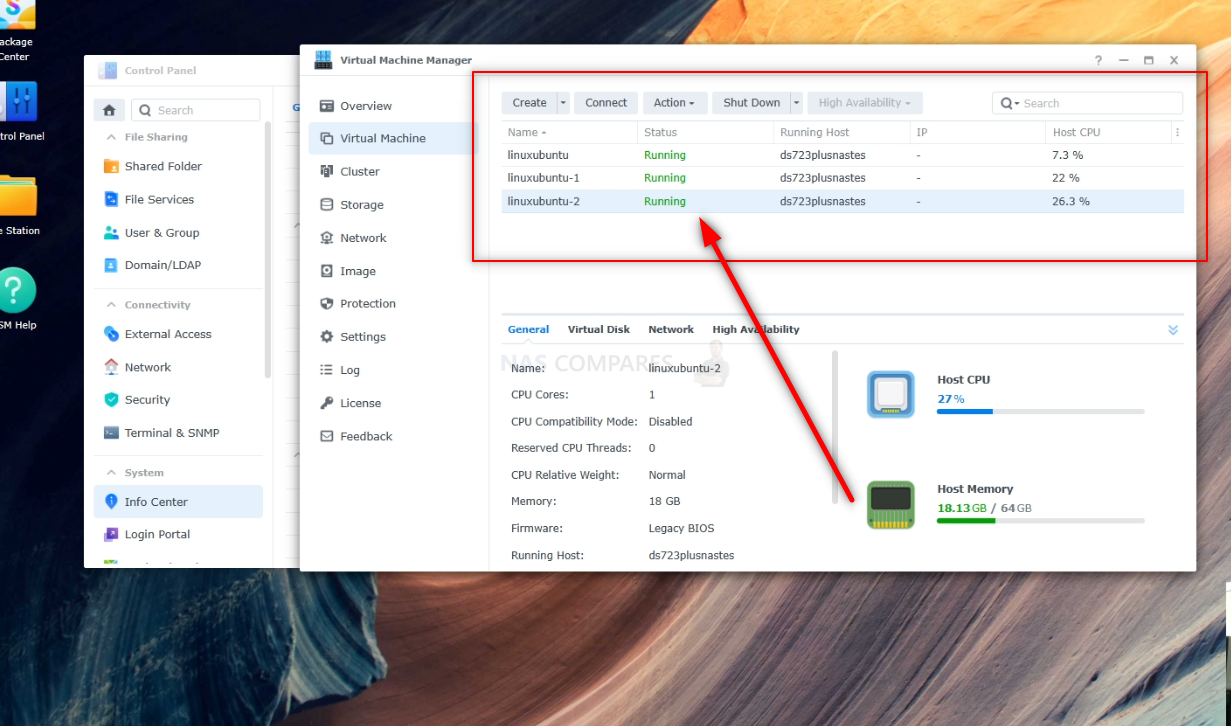
So, those were the three unofficial memory types that I tested on the Synology DS1522+ NAS. However, it is VERY important that (regardless of whether you choose official or unofficial memory for your NAS upgrade) you check that your memory is working perfectly. Do check this; you should use the built-in Memory Testing facility of Synology Assistant for PC/Mac. Below is how to conduct the test.
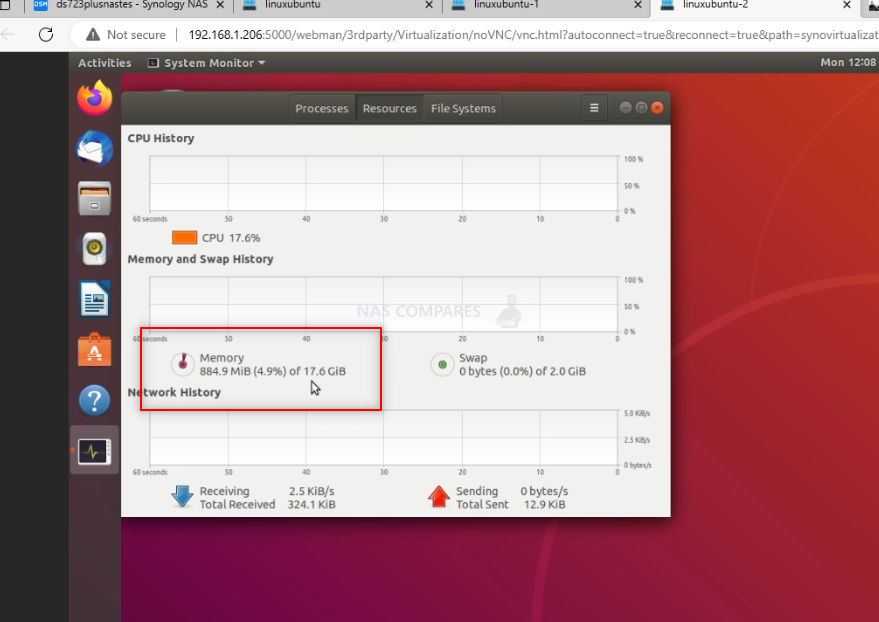
Synology DS1522+ Official/Unofficial Memory Upgrade – Step 4, Checking the Memory is Usable
There are several ways to check the memory is working on your Synology DS1522+ correctly. One easy method that can be done very quickly is using the Synology Memory Test tool.
To run a memory test:
-
- Download and install the Synology Assistant, where you can find the memory test function. The application is available at Download Center.
- Open Synology Assistant, click and enable the memory test service.

-
- Select the device where you wish to run the test and click Memory Test.

- Select the device where you wish to run the test and click Memory Test.
During the memory test, your Synology NAS will be rebooted. It will recover after another reboot if its memory is normal and passes the test. However, if the memory test fails to finish or shows that there is an error, the memory may be faulty. In this case, you are strongly recommended to return your Synology NAS for repair. Just in case you have installed a non-Synology memory module, please remove it and rerun the memory test.
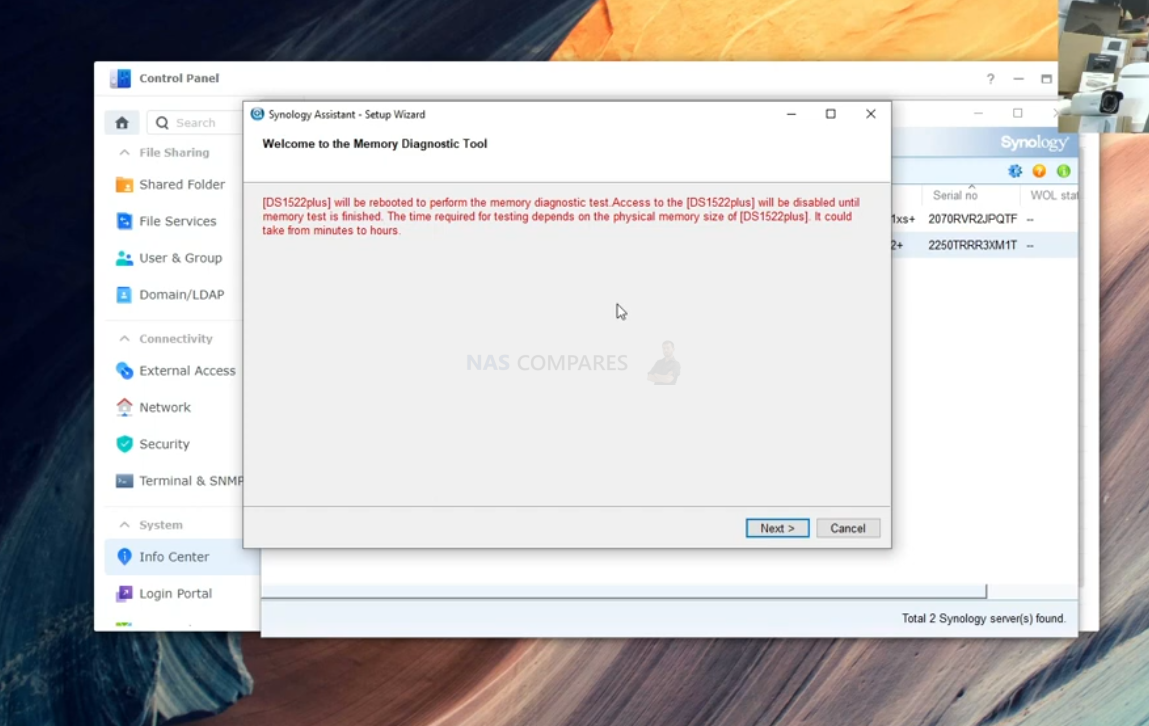
Though once again you should remember that Synology do not recommend using memory modules that are not from Synology themselves, so this test may not be indicative of the health of unofficial memory in your Synology NAS. Alternatively, you can perform as many actions and processes as possible (scans, copy/pastes, thumbnail generation, transcode a 4K file, RAID changes, synchronisation, etc) at once to see how the task manager and resource monitor behaves in the Synology DS1522+. It should spike each time and at a greater height as you do more and more and once it exceeds the memory you had previously installed, this is a good confirmation that the installation is working fine. Alternatively, you can temporarily allocate chunks of memory and then that is a much more reliable test. Install the virtual machine application for the Synology DS1522+ (P.S. for Synology users it is the Virtual Machine Manager and for QNAP it is the Virtualisation station). Then you can create individual VMs (it is alot easier than it sounds and the Synology DS1522+ VM software is very user-friendly) then allocate a large number of GBs (Gigabytes) of memory to each one. When you have created 3 or 4 individual virtual machine containers on the Synology DS1522+ software, then you can run them all at once and that will immediately use almost all the memory at once! If there are any issues with the memory, it will show here almost immediately. If no problems, then you know the Synology DS1522+ unofficial Crucial/Kingston memory installation as successful. You can then delete the VMs in the virtual machine software and then free up all that memory again.
- Link below for Tested RAM modules from Crucial, Kingston, Samsung, Timtec and Synology Official Memory too:
| DS1522+
(Arrives with ECC Memory) |
DDR4-2466 ECC Unbuffered SO-DIMM 260pin 1.2V | D4ES02-8G (ECC)
D4ES01-16G (ECC) |
Crucial ECC 4GB – Buy Here
Kingston NON-ECC 4GB- Buy Here Crucial NON-ECC 8GB – Buy Here Kingston NON-ECC 8GB- Buy Here Crucial NON-ECC 16GB – Buy Here Kingston NON-ECC 16GB- Buy Here Kingston NON-ECC 32GB – Buy Here Kingston ECC 8GB – Buy Here Arch ECC 16GB – Buy Here vColour ECC 32GB- Buy Here |
VERY IMPORTANT – The Links used in the article below towards the correct unofficial memory are occasionally changed (beyond my control) as it will direct you to the site in your own region/country. MAKE SURE to check that the memory module (especially 16 and 32GB SODIMM modules) are DUAL RANK or ‘DR‘, as Synology NAS typically have trouble with SR/SINGLE RANK modules.
🔒 Join Inner Circle
Get an alert every time something gets added to this specific article!
This description contains links to Amazon. These links will take you to some of the products mentioned in today's content. As an Amazon Associate, I earn from qualifying purchases. Visit the NASCompares Deal Finder to find the best place to buy this device in your region, based on Service, Support and Reputation - Just Search for your NAS Drive in the Box Below
Need Advice on Data Storage from an Expert?
Finally, for free advice about your setup, just leave a message in the comments below here at NASCompares.com and we will get back to you. Need Help?
Where possible (and where appropriate) please provide as much information about your requirements, as then I can arrange the best answer and solution to your needs. Do not worry about your e-mail address being required, it will NOT be used in a mailing list and will NOT be used in any way other than to respond to your enquiry.
Need Help?
Where possible (and where appropriate) please provide as much information about your requirements, as then I can arrange the best answer and solution to your needs. Do not worry about your e-mail address being required, it will NOT be used in a mailing list and will NOT be used in any way other than to respond to your enquiry.

|
 |
Minisforum N5 Pro NAS - Should You Buy?
UGREEN DH4300 & DH2300 NAS Revealed - Good Value?
Aoostar WTR Max NAS - Should You Buy?
Xyber Hydra N150 NAS Review - Is This COOL?
Minisforum N5 Pro vs Aoostar WTR Max - The BIG Showdown
Do MORE with Your M.2 Slots - GREAT M.2 Adapters!
Access content via Patreon or KO-FI







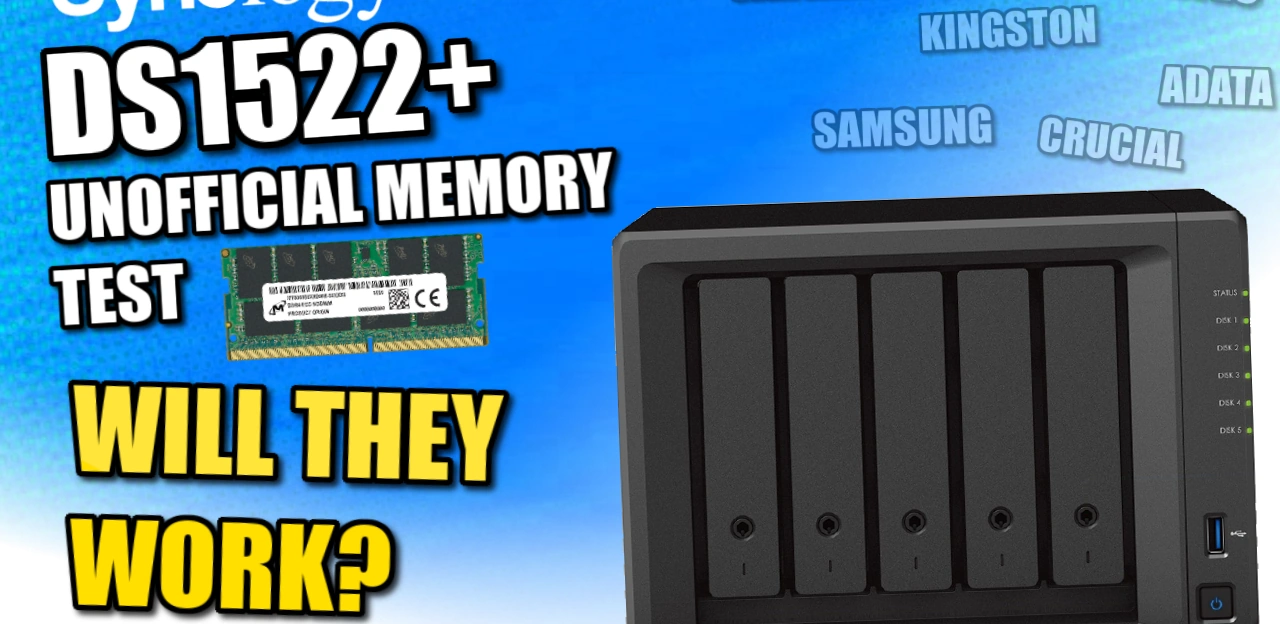
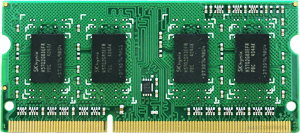
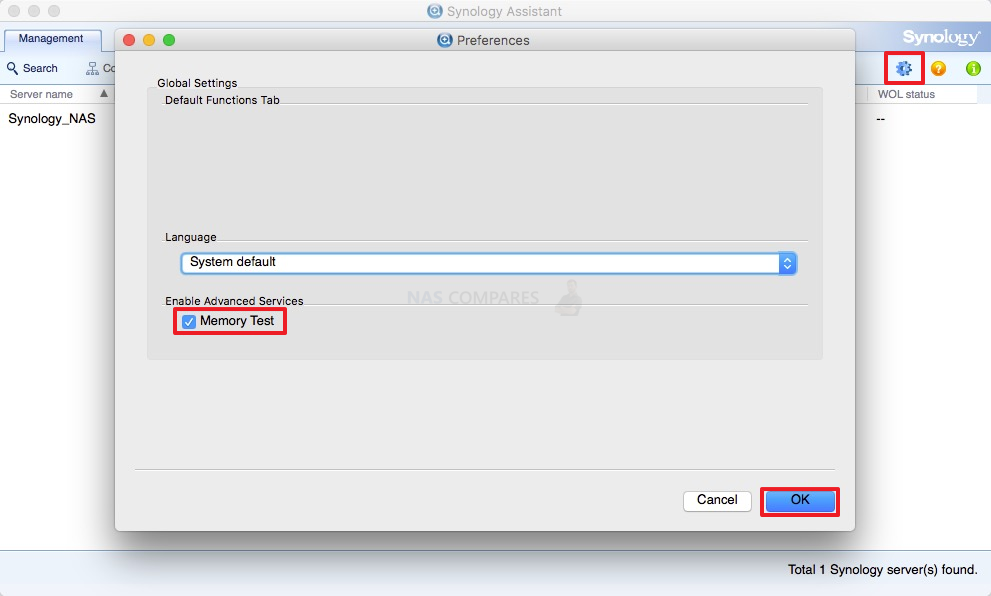
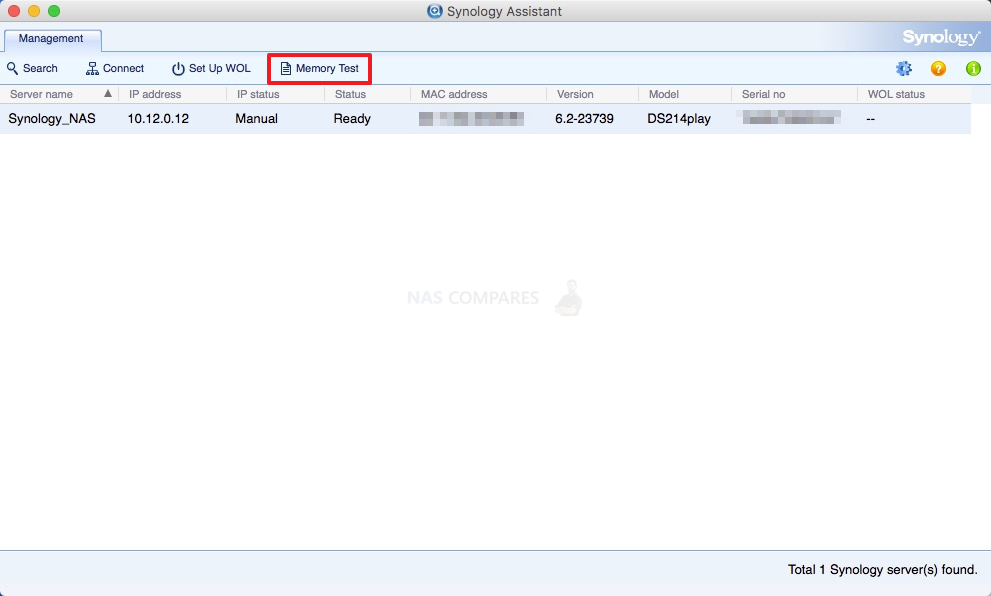



Shoud i use ECC or non ECC unbuffered? wich works best?
REPLY ON YOUTUBE
STOP READING HIS TABS!
REPLY ON YOUTUBE
STOP READING HIS TABS!
REPLY ON YOUTUBE
Your channel is as close to perfection as one can get. Every single video is deliberate and immensely useful. Never a miss.
REPLY ON YOUTUBE
Having used computers for thirty years, I have never noticed an issue where I have lost data due to an error. The risk of significant loss of data due to using non-ECC memory must be very, very small: close to zero.
REPLY ON YOUTUBE
I installed OWC 32GB (2X16GB) DDR4 RAM purchased from Amazon. Took about 20 minutes to initialize and boot up the first time. This was 3 months ago now it takes 8 minutes to boot up. Also I can’t get more than 24 gigs of RAM out of the 32 gigs. I tried to SSH in and change it to 32gb with no luck. Other than that it’s working fine for me.
REPLY ON YOUTUBE
Thank you for in-detail info. looking forward to your next videos.
REPLY ON YOUTUBE
Asrock AM4 mobos ftw.
REPLY ON YOUTUBE
Ryzen 9 7950X supports ECC RAM.
Also, some consumer motherboards, like the ASRock X670E Taichi mention the support for ECC & non-ECC DIMMs.
Will a combo like that work with ECC RAM 100%?
REPLY ON YOUTUBE
I’m a software developer. I have tens of thousands of lines of codes stored on my computers, some of the code being decades old. A flipped bit in any of those text files would likely manifest as a syntax error when I compiled the source code. In all those years and all those lines of code I have not once experiences such a syntax error from a flipped bit. I think the problem is overblown for the typical user. For a corporation that keeps a giant multi-terabyte database in memory for months on end maybe it could be an issue.
REPLY ON YOUTUBE
“it has no advantages for home users”
Enter AI personal assistants with home nas backup. ????
REPLY ON YOUTUBE
I tired a Kingston 8GB KCP426SS6/8 it didn’t work, after googling seems other people with with a synnology nas it didn’t work but the 4GB variant did
REPLY ON YOUTUBE
Any system with long uptimes should be using ECC, almost without regard for the system size (An exception at the microcontroller level, but they use a different kind of memory cell anyway). The longer the uptime the more chance for errors to propagate through the calculations. All modern 64bit machines are large machines, 1GB of memory is substantial in regard to bit flip error rates. A corrupted pixel in a video is inconsequential but if the corrupted bit is within a CPU instruction, a starting constant in a long calculation, or part of some compressed data then the effect can have a chain reaction.
eg. JPG images are very sensitive, due to the high level of compression one bit flip can destroy the color over half or more of the photograph. (While an uncompressed bitmap would only slightly scew one pixel, at the cost of 10 times the data so maybe a few scewed pixels.)
Yes the 10% cost may appear huge at exascale but consider the impact of error uncertainty when a single computation set uses weeks of machine time and $100k just in electricity cost.
REPLY ON YOUTUBE
If the EU can legally force Apple to switch to USB-C. Why can’t we force manufacturers to make ecc a legal standard?
REPLY ON YOUTUBE
Synology nas ds1522+ should i get 2 16gb stick or one 32gb stick in regarding dual channel. Is there any performance gain with 2 sticks?
REPLY ON YOUTUBE
Can you post a affiliate link for your suggested combination to get 64gb of Ram. Thanks for your research.
REPLY ON YOUTUBE
The Asustor AS6704T NAS that I use has the Intel N5105 which doesn’t support ECC.
REPLY ON YOUTUBE
Can I install ecc 2666mhtz 8gb ram on my ds920+?
REPLY ON YOUTUBE
My comment ended up flagged/deleted? Kinda sad considering I was saying thanks for making this video. I don’t really understand YouTube at all. Hopefully you can review my comment as it had helpful info for everyone. I’m going to purchase some ram from one of the Amazon links in the description so, hopefully that helps a little.
REPLY ON YOUTUBE
Thank you for such a detailed review for ram on this machine! I couldn’t believe how much Synology’s own ram cost on these. Just insane. I do plan to get the DS1522+, and 32GB ram for it.
REPLY ON YOUTUBE
Thks & you’re quite amazing Mr RAM
REPLY ON YOUTUBE
3:30 also literal cosmic rays. It’s nuts.
REPLY ON YOUTUBE
Just installed 2x Kingston MSI32D4S2S1ME-8 8GB 260Pin SO-DIMM DDR4 — Working great so far in the DS1522+,
also put in 2x 1TB WD blue M.2 NVMe and 5x WD RED 18tbs in RAID 6
REPLY ON YOUTUBE
Please Post the Product Number of the 32 GB Crucial Module. I bought the 923+ and want to use also the 64 GB Variant.
REPLY ON YOUTUBE
ECC is not an acronym, but an initialism. If it were an acronym, we would be pronouncing it as ‘eck’ , not ‘eee cee cee’ ????
REPLY ON YOUTUBE
The link in the description for the crucial 16 GB, is a link to 16 gigs of laptop memory. Can you please make the change to this error.
REPLY ON YOUTUBE
can you upgrade just the empty ram slot (ex Crucial 16GB CT16G4SFD8266) and use it with the original 8GB, so i do have 24GB ram?
REPLY ON YOUTUBE
Do you have a video testing the m.2 sdd for the 1522+ I want to know which options I have different than the synology m.2 sdd. Thanks.
REPLY ON YOUTUBE
Thanks for these tests very helpful!
As for the microphone bass thumps, maybe you can try putting a steep 60-80hz high-pass audio filter to minimize them? Or a mount attached to the wall.
REPLY ON YOUTUBE
Did you ever get a chance to run the memory test against the 64GB setup?
REPLY ON YOUTUBE
14:12 Seagulls xD
REPLY ON YOUTUBE
Maybe it helps others, but the Timetec 8GB ECC 2600MHz memory on Amazon works in the DS1522 quite well and allows you to double your memory from 8GB to 16GB using the existing module installed and is under $35. Can’t seem to post a link to Amazon without it getting rejected…
REPLY ON YOUTUBE
Thankyou, went with 2x Kingston Server Premier – DDR4 16 GB – SO DIMM 3200 MHz / PC4-25600 – CL22 – 1.2 V ECC KSM32SED8/16MR. My thinking why not use parity ECC memory when it’s not very expensive. 32GB.
REPLY ON YOUTUBE
I really like your seagull. 🙂 Won’t lose her.
REPLY ON YOUTUBE
will you test to see if it’s stable? and make a video to let us now the results?
REPLY ON YOUTUBE
Great video, and very helpful!
I would like to know if it’s possible to just add one of these memory sticks to the 8GB that comes with the NAS?
REPLY ON YOUTUBE
No ESD strap while handling memory ????????????
REPLY ON YOUTUBE
I did try out a QNAP NAS which I had upgraded to 64GB of RAM and it took ages (many minute) to boot – pretty dreadful considering it had it’s OS on an internal solid state boot device and I had also added 2 x NVMe for caching/ZFS support…
REPLY ON YOUTUBE
I don’t generally look at your tabs. Nice!
REPLY ON YOUTUBE
????????????????????????????????????????????????????????????????????????
REPLY ON YOUTUBE
????????????????????????????????????????????????????????
REPLY ON YOUTUBE
Nice content!
REPLY ON YOUTUBE
????????????????????????????????????????????????????????
REPLY ON YOUTUBE
Hello!
REPLY ON YOUTUBE